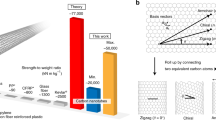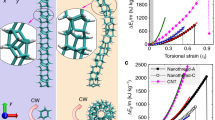Abstract
IT has been suggested1 that the tensile strength of carbon nanotubes2 might exceed that of other known fibres because of the inherent strength of the carbon–carbon bond. Calculations of the elastic properties of nanotubes confirm that they are extremely rigid in the axial direction and are most likely to distort perpendicular to the axis3'4. Carbon nanotubes with localized kinks and bends5'6, as well as minor radial deformations7'8, have been observed. Here we report the existence of multi-shelled carbon nanotubes whose overall geometry differs radically from that of a straight, hollow cylinder. Our observations reveal nanotubes that have suffered complete collapse along their length. Theoretical modelling demonstrates that, for a given range of tube parameters, a completely collapsed nanotube is favoured energetically over the more familiar 'inflated' form with a circular cross-section.
This is a preview of subscription content, access via your institution
Access options
Subscribe to this journal
Receive 51 print issues and online access
$199.00 per year
only $3.90 per issue
Buy this article
- Purchase on Springer Link
- Instant access to full article PDF
Prices may be subject to local taxes which are calculated during checkout
Similar content being viewed by others
References
Ross, P. E. Scient. Am. 265 (December), 24 (1991).
Iijima, S. Nature 354, 56–58 (1991).
Overney, G., Zhong, W. & Tomanek, D. Z. Phys. D27, 93–96 (1992).
Tersoff, J. & Ruoff, R. S. Phys. Rev. Lett. 73, 676–679 (1994).
Endo, M. et al. J. Phys. Chem. Solids 54, 1841–1848 (1993).
Despres, J. F., Daguerre, E. & Kafdi, K. Carbon 33, 87–92 (1995).
Ruoff, R. S., Tersoff, J., Lorents, D. C., Subramoney, S. & Chan, B. Nature 364, 514–516 (1993).
Hiura, H., Ebbesen, T. W., Fujita, J., Tanigaki, K. & Takada, T. Nature 367, 148–151 (1994).
Kratschmer, W., Lamb, L. D., Fostiropoulos, K. & Huffman, D. R. Nature 347, 354–358 (1990).
Ebbesen, T. W. & Ajayan, P. M. Nature 358, 220–222 (1992).
Ebbesen, T. W., Ajayan, P. M., Hiura, H. & Tanigaki, K. Nature 367, 519 (1994).
Colbert, D. T. et al. Science 266, 1218–1222 (1994).
Adams, G. B., Sankey, O. F., Page, J. B., O'Keefe, M. & Drabold, D. A. Science 256, 1792–1795 (1992).
Robertson, D. H., Brenner, D. W. & Mintmire, J. W. Phys. Rev. B45, 12592–12595 (1992).
Sawada, S.-I. & Hamada, N. Solid St. Commun. 83, 917–919 (1992).
Safran, S. A. Statistical Thermodynamics of Surfaces and Interfaces (Addison Wesley, Reading, MA, 1994).
Blase, X., Rubio, A., Louie, S. G. & Cohen, M. L. Europhys. Lett. 28, 335–340 (1994).
Girifalco, L. A. & Lad, R. A. J. chem. Phys. 25, 693–697 (1956).
Bacon, R. J. appl. Phys. 31, 283–290 (1960).
Iijima, S. in Proceedings Thirty-seventh Annual Meeting Electron Microscopy Society of America 392–395 (Claitor's, San Antonio, TX, 1979).
Author information
Authors and Affiliations
Rights and permissions
About this article
Cite this article
Chopra, N., Benedict, L., Crespi, V. et al. Fully collapsed carbon nanotubes. Nature 377, 135–138 (1995). https://doi.org/10.1038/377135a0
Received:
Accepted:
Issue Date:
DOI: https://doi.org/10.1038/377135a0
This article is cited by
-
Failure-analysis of carbon nanotubes and their extreme applications
Nano Research (2023)
-
Squashing carbon nanotubes into nanoribbons
Nature Electronics (2021)
-
Structure and electronic properties of deformed single-walled carbon nanotubes: quantum calculations
Structural Chemistry (2018)
-
Spontaneous twisting of a collapsed carbon nanotube
Nano Research (2017)
-
Self-assembly of graphene ribbons by spontaneous self-tearing and peeling from a substrate
Nature (2016)
Comments
By submitting a comment you agree to abide by our Terms and Community Guidelines. If you find something abusive or that does not comply with our terms or guidelines please flag it as inappropriate.



